KeithB
Resident Half Fast Machinist
What do you do when your only CNC lathe is tied up running a high dollar job for the next 3-1/2 weeks and one of your best customers drops another lathe job in your inbasket and wants the parts in a week and a half? Here is what is needed:
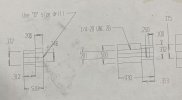
These two little parts are made from 1/2" diameter 6061 aluminum round stock. One end of each of these has a .372" turn .313" long. The interior details are different as are the lengths but the ends are identical. I decided to turn the ends on our manual lathe, cut them off to allow some finish stock on the opposite end, and then turn them around around and face them off to length. Then I can move them over to the CNC mill to drill and tap the interior holes. Drilling and tapping on a manual lathe is a pain!
My lathe has a wedge type toolholder system which is great, it allows for easily interchanging an almost infinite variety and number of tools. (My digital readout will allow storing data on 50 tools.) The downside is that for small parts like these you spend a lot of time and effort switching between a turning/facing tool and a cutoff tool. You also lose a little bit of accuracy when changing tools. Just like a scope, if you want the best accuracy you mount it solid and leave it the hell alone.
I decided that for a lazy sort like me I needed to make a single toolholder to hold two tools so I could do all the turning, facing, and cutting off without having to constantly change tools. (You think an iron mould gets heavy after a long session...) Years ago I altered a wedge type toolholder to allow for a facing tool and a center drill in one unit so we could face the end of a 2" shaft and then center drill it w/o changing tools. I decided to use this toolholder as a basis for making what was needed for this job. The wedge type toolholder and spacer block were retained and two additional parts - a cutoff toolholder and a clamp/cover plate were made. The turning/facing tool is a standard indexable carbide turning toolof the WNMG variety. We keep several replacement cutoff tools around as spares. This one is 1" tall x 1/8" thick and holds a 5/32" (.156") wide carbide insert.
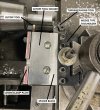
A lathe tool has to be set at the right height to cut to center. I had to make sure that both tools could be adjusted independently. The turning/facing tool in the wedge block could be adjusted using the standard height adjusting screw on the wedge block. The cutoff toolholder block needed a height adjustment mechanism, so the anchor holes were made as slots to allow for some up/down movement and a couple of round head screws were used as a fine adjustment. The bottom of the screw heads bear on the top of the spacer block.
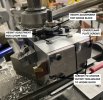
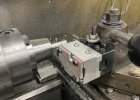
It was pretty easy to adjust, just get the turning tool on center, lock it in place, and then adjust the cutoff tool and lock it in place. It took a little fiddling to get the tools fine tuned to minimize motion and work while still allowing for enough room not to crash anything together.
Here are the three cutting steps:
Face the end. Note cutoff tool clearance.
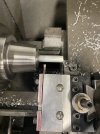
Turn the .372" diameter.
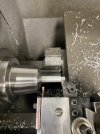
Cut off the part
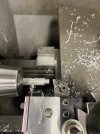
In order to keep track of the parts I took a piece of scrap wood and made a parts tray to hold 50 pieces.
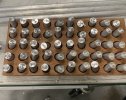
Once I got rolling I was making about 40 pieces an hour without really working all that physically hard. I always try to work smarter not harder.

These two little parts are made from 1/2" diameter 6061 aluminum round stock. One end of each of these has a .372" turn .313" long. The interior details are different as are the lengths but the ends are identical. I decided to turn the ends on our manual lathe, cut them off to allow some finish stock on the opposite end, and then turn them around around and face them off to length. Then I can move them over to the CNC mill to drill and tap the interior holes. Drilling and tapping on a manual lathe is a pain!
My lathe has a wedge type toolholder system which is great, it allows for easily interchanging an almost infinite variety and number of tools. (My digital readout will allow storing data on 50 tools.) The downside is that for small parts like these you spend a lot of time and effort switching between a turning/facing tool and a cutoff tool. You also lose a little bit of accuracy when changing tools. Just like a scope, if you want the best accuracy you mount it solid and leave it the hell alone.
I decided that for a lazy sort like me I needed to make a single toolholder to hold two tools so I could do all the turning, facing, and cutting off without having to constantly change tools. (You think an iron mould gets heavy after a long session...) Years ago I altered a wedge type toolholder to allow for a facing tool and a center drill in one unit so we could face the end of a 2" shaft and then center drill it w/o changing tools. I decided to use this toolholder as a basis for making what was needed for this job. The wedge type toolholder and spacer block were retained and two additional parts - a cutoff toolholder and a clamp/cover plate were made. The turning/facing tool is a standard indexable carbide turning toolof the WNMG variety. We keep several replacement cutoff tools around as spares. This one is 1" tall x 1/8" thick and holds a 5/32" (.156") wide carbide insert.

A lathe tool has to be set at the right height to cut to center. I had to make sure that both tools could be adjusted independently. The turning/facing tool in the wedge block could be adjusted using the standard height adjusting screw on the wedge block. The cutoff toolholder block needed a height adjustment mechanism, so the anchor holes were made as slots to allow for some up/down movement and a couple of round head screws were used as a fine adjustment. The bottom of the screw heads bear on the top of the spacer block.


It was pretty easy to adjust, just get the turning tool on center, lock it in place, and then adjust the cutoff tool and lock it in place. It took a little fiddling to get the tools fine tuned to minimize motion and work while still allowing for enough room not to crash anything together.
Here are the three cutting steps:
Face the end. Note cutoff tool clearance.

Turn the .372" diameter.

Cut off the part

In order to keep track of the parts I took a piece of scrap wood and made a parts tray to hold 50 pieces.

Once I got rolling I was making about 40 pieces an hour without really working all that physically hard. I always try to work smarter not harder.
Last edited:
